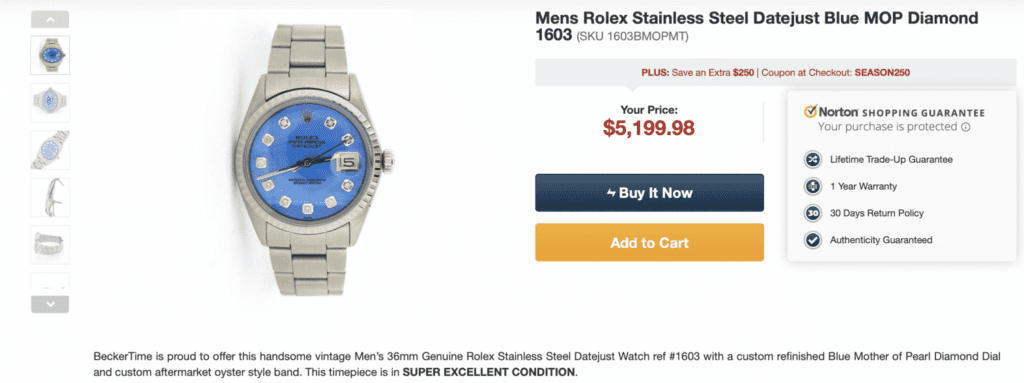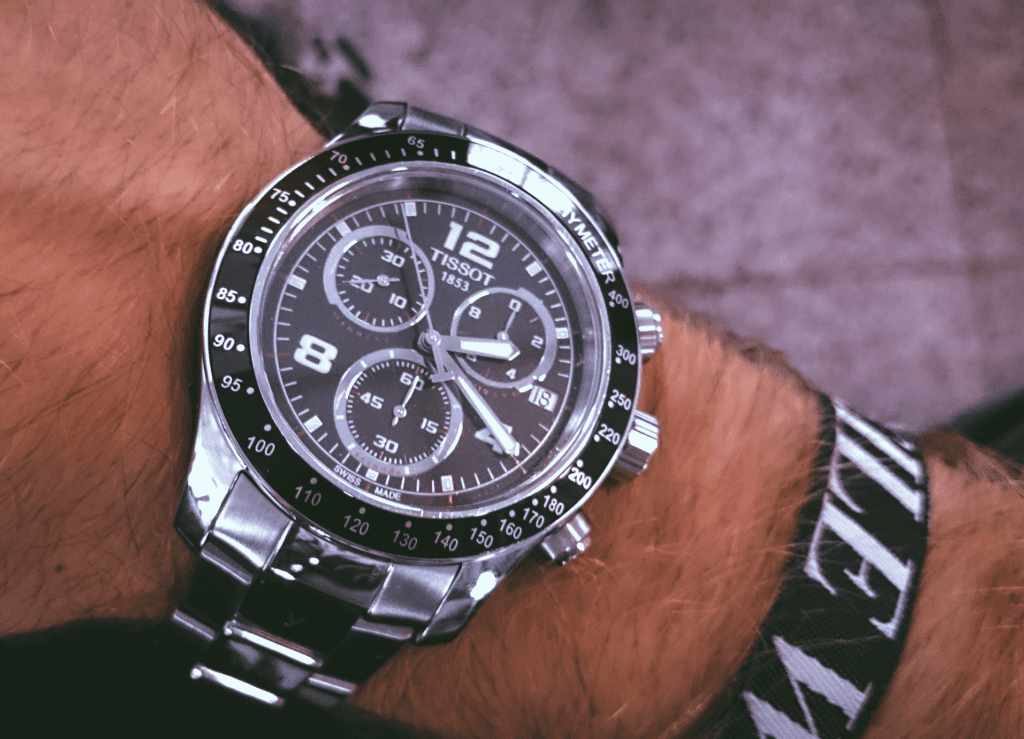A federal appeals court has sounded off in a Rolex-initiated case over the marketing and sale of modified luxury watches, confirming that a third-party watch seller ran afoul of Rolex’s trademark rights by offering up modified watches without making sufficient disclosures about the nature of the timepieces. In a decision dated January 26, a panel of judges for the U.S. Court of Appeals for the Fifth Circuit held that the U.S. District Court for the Northern District of Texas applied the appropriate test to determine whether BeckerTime infringed Rolex’s trademark by selling watches that contained both Rolex and non-Rolex parts, and marketing them as “Genuine Rolex” goods.
In addition to shedding light on the proper way to gauge trademark infringement when it comes to certain pre-owned goods, the Fifth Circuit provided a dive into some of the legal ins-and-outs of marketing and selling modified and/or customized watches when another party’s trademarks are in play.
Some Background: Rolex sued BeckerTime back in 2020, alleging that the pre-owned watcher-seller was engaging in counterfeiting and trademark infringement by way of its use of Rolex’s trademarks to advertise service, and sell watches and individual watch parts that “are not authorized or sponsored by Rolex and that are not genuine [Rolex] products.” Following a bench trial in 2021, the Northern District of Texas sided in part with Rolex. It found that BeckerTime infringed Rolex’s trademarks by offering up Rolex trademark-bearing watches despite making extensive modifications (including the addition of “diamonds,” “aftermarket bezels,” and “aftermarket bracelets or straps”) to the watches and failing to include sufficient disclosures about the modified watches, thereby, causing confusion among consumers.

In a partial win for BeckerTime, the court refused to disgorge its profits on the basis that the laches defense applied. BeckerTime successfully argued that Rolex waited too long to act since it “should have known about BeckerTime in 2010, ten years prior to the filing of the lawsuit, and no later than 2013.”
Both parties appealed, with Rolex seeking a modification to the injunction, treble profits, and attorneys’ fees, and BeckerTime arguing that the lower court erred in its analysis of likelihood of confusion.
The Issue of Infringement
Fast forward to January 26 and the Fifth Circuit issued its opinion in the case. Primarily taking on the issue of likelihood of confusion, the appeals court considered whether the lower court applied the correct framework. BeckerTime argued that “a modified test for infringement involving ‘decades’ old’ products arises from the Supreme Court’s decision in Champion Spark Plug Co. v. Sanders” and that the district court “improperly applied the traditional likelihood of confusion factors without any discussion of Champion.” Rolex countered, claiming that the district court applied the correct framework, as it “appropriately followed Rolex Watch USA, Inc. v. Meece, and other established precedent involving altered watches.”
Rather than suggesting that Champion is inapplicable, the Fifth Circuit stated that “Rolex argues that the district court implicitly concluded that Champion’s ‘misnomer’ exception applie[s] in the instant case.”
Champion in a nutshell: At its core, Champion “instructs that a reseller may utilize the trademark of another, so long as it involves nothing more than a restoration to the original condition, and not a new design,” and if that is the case, “[f]ull disclosure gives the manufacturer all the protection to which he is entitled.”
The Misnomer Exception: The Fifth Circuit also noted that in Champion, the Supreme Court carved out an exception to the foregoing rule for instances where “the reconditioning or repair would be so extensive or so basic that it would be a misnomer to call the article by its original name, even though the words ‘used’ or ‘repaired’ were added.’”
Distinguishing the case at hand from the facts in Champion, where the misnomer exception did not apply because that case involved “no more than a restoration … of [the spark plugs’] original condition,” the Fifth Circuit asserted that BeckerTime did more than merely “recondition or repair” the watches at issue. Instead, it produced modified watches that are “materially different than those sold by Rolex.” In fact, the Fifth Circuit maintained that the modifications ultimately transformed the originally-authentic Rolex watches into watches “of another make” so much so that they “cannot properly be called genuine Rolex watches” anymore.
Against that background and based in its review of the record, the Fifth Circuit held that the lower court did not err in considering – and then properly applying – Champion’s misnomer exception in the case at hand and then conducting a traditional likelihood of confusion (“LOC”) analysis. In applying the LOC factors, the appeals court found “no clear error in the district court’s determination that BeckerTime infringed Rolex’s trademark because its watches, lacking sufficient disclosures, created a likelihood of confusion in consumers.”
Scope of Relief, Injunction
Beyond the issue of infringement, the Fifth Circuit addressed Rolex’s arguments about the scope of relief granted by the district court. The appeals court said, in part, that the district court correctly decided that: (1) BeckerTime should not be disgorged of profits resulting from Rolex’s delay in filing suit; and (2) Rolex is not entitled to treble profits and attorneys’ fees under 15 U.S.C. § 1117(b).
In another partial win for Rolex, the Fifth Circuit panel found that while the district court blocked BeckerTime from further displaying the “GENUINE ROLEX” trademark “in any disclosures in connection with goods or services of watches that include: non-genuine (i.e. not made by Rolex) bezels,” it erred by not going further and enjoining BeckerTime from using “non-genuine bezels and non-genuine dials” on Rolex-branded watches. “We agree with Rolex that the district court should have enjoined the sale of Rolex watches with non-genuine bezels,” the Fifth Circuit stated, noting that “the district court specifically found that ‘advertisements labeling watches with a non-genuine bezel as a Rolex are likely to confuse customers.’” The district court also asserted that “like dials and bracelets, bezels ‘are integral and necessary to the at-issue watches.’”
Additionally, the court took on …
> Rolex’s argument that the district court was wrong to prohibit BeckerTime’s sale of “dials where the dial is stripped of the original paint/coating and markings, then repainted/recoated, … or to which other words have been added,” but not the sale of “customized dials that do not involve the removal or reapplication of Rolex’s trademarks, and which may have added diamonds, stones, or other embellishments.” Citing Champion, the Fifth Circuit held that “there is a difference between adding diamonds to a dial and refinishing a dial – the former is customization [and] the latter is restoration.” The court claimed that BeckerTime’s restoring/refinishing process “necessarily required [it to] remove and reapply Rolex’s trademarks, whereas there is no evidence that the customization process involved removing and reapplying Rolex’s trademarks.
As such and “with the right disclosures, as required by the injunction, BeckerTime is free to customize watches for customers upon request,” per the Fifth Circuit.
> Rolex’s argument that the district court erred in requiring BeckerTime to inscribe “CUSTOMIZED BY BECKERTIME” on the back of the watches on the basis that BeckerTime should be barred from selling such “counterfeit” watches full stop. Rejecting Rolex’s claim, the Fifth Circuit held that “it is reasonable that the district court required an additional disclosure to adequately alleviate any remaining confusion” since the disclosure language that BeckerTime previously used did not “fully alleviate confusion.”
> Rolex’s argument that the district court improperly permitted BeckerTime to sell counterfeit watches upon customer request. “The district court reasonably found that, with the required disclosures, no customer requesting a customized watch by BeckerTime would confuse it with a genuine Rolex watch,” the Fifth Circuit stated.
The case will now go back before the district court for a “limited remand” to clarify certain language in its order.
The case is Rolex Watch USA, Inc., v. BeckerTime LLC, et al., 4:20-cv-01060 (N.D. Tex).











